The usefulness of catheters in minimally invasive surgical procedures is undeniable. Their small size and compact structures enable them to reach the deeper tissues to achieve multiple functions such as the delivery of drug molecules, removal of blood clots, insertion of implant-like stents, etc. Thus their vast functionality, along with minimum side effects as well as associated risks, renders them the device of choice.
In recent years, the latest developments in the field of medical science have resulted in the improvement of several medical devices including catheters. Hence, the development of microelectronic catheters has come into being.
What are microelectronic catheters?
Microelectronic catheters, or as they are also referred to, electronically integrated or electroceutical catheters, are medical devices that can deliver drug substances into the body or take tissue or fluids out of the body as test samples. Their diameter ranges from 0.70 to 1.30 mm. Polytetrafluoroethylene or PTFE is the preferred material used for the manufacturing of microelectronic catheters. These microelectronic catheters have been modified to fix all the subcomponents into a micro-sized tubular structure which makes them sleek and even more useful for conducting minimally invasive surgeries.
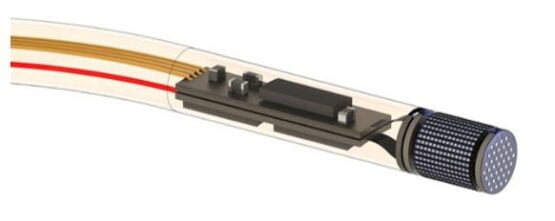
Microelectronic catheter
Design of microelectronic catheter
Microelectronic catheters are hair-thin structures with an average diameter of 0.1 mm. Their improved design has a pre-fixed sensor and an actuator which, in previous designs, were to be fixed manually prior to use. These microelectronic catheters have the following components:
Sensors: These are navigated into the body for their proper placement and positioning using pre-fixed magnetic sensors. These sensors also serve other functions such as pH measurement, temperature estimation, and blood pressure monitoring. In addition, these are also equipped to analyze, both qualitatively and quantitatively, the gases present in the blood. Similarly, biomolecular detection is also an application of these sensors.
Microfluidic channel: These microelectronic catheters also possess a microfluidic channel which is used for the delivery of drugs or liquid substances.
Gripping instrument: A gripping instrument is attached at the tip of the microelectronic catheter which delivers or takes out the microscopic objects. This way, tissue sampling can also be done. Moreover, this gripping function enables the catheter to grasp and remove the blood clots from the vessels.
Working with microelectronic catheters
Insertion of a microelectronic catheter is a simple process that may vary depending upon the purpose of its insertion. Generally, for the removal of particles or sampling, the following steps are adopted:
- A microelectronic catheter is guided into the blood vessel until it reaches the particle intended to be removed.
- By keeping it near the particle, its gripping tip is opened and brought near the substance.
- The tip captures the particles tightly which is then retracted back similarly as it was guided inside the vessel.
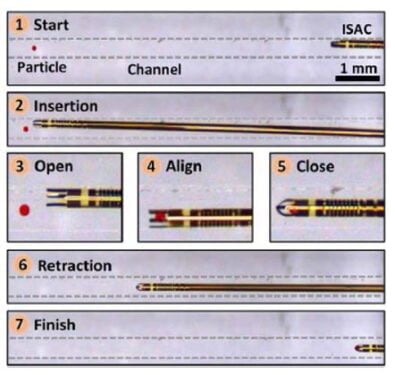
The process of insertion of a microelectronic catheter
If the catheter is inserted for the purpose of removing plagues from the blood vessels, e.g. from the coronary artery, the catheter is guided into the blood vessel which its balloon deflates to press the plague sideways. This type of catheter has two subcomponents:
- An ePATCH is a flexible electrode patch containing a coating of voltage or one-part-voltage-activated adhesive.
- A CATRE is a microelectronic catheter used for minimally invasive surgeries. It contains a retractable electrode to transfer the ePATCH to its place within the blood vessel. Once it reaches the target site, the catheter balloon will inflate and the patch will be put at its intended place.
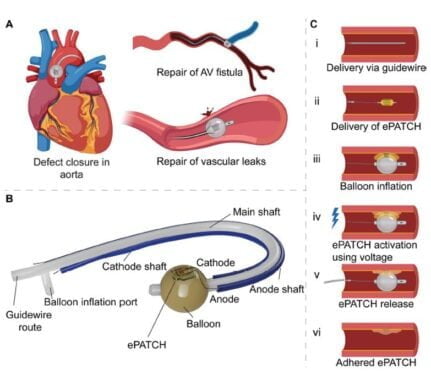
Microelectronic catheter being employed to open and repair the clogged arteries
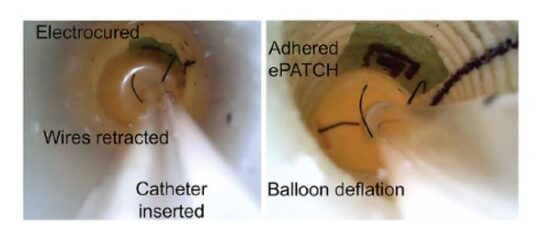
A catheter balloon can be seen being inflated at the target site
Applications
Microelectronic catheters have multiple applications, some of which are enlisted below:
- These catheters are applicable in multiple surgeries such as those conducted to alleviate an aneurysm which is the bulging into the blood vessels. These aneurysms, if go untreated, can be fatal.
- Microelectronic catheters can also be used to fix vascular malformations which can be both congenital and acquired.
- Pancreatic surgeries also employ microelectronic catheters.
- Arteriovenous fistula (AV) i.e. irregular linkages between an artery and a vein are also fixed by using microelectronic catheters.
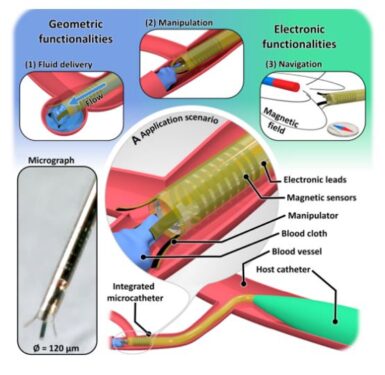
Functions of microelectronic catheters
- These microelectronic catheters can also help in accessing the distal anatomical structures in the body which are otherwise hard to reach.
Future predictions regarding the microelectronic catheters
Despite the fact that the development of microelectronic catheters, like many other minimally invasive interventions, is lingering along it. A prominent limitation of their use is the necessity of personnel training. Moreover, modifications in the design of the microelectronic catheters are still required to make these more compact as well as highly efficient. Once these changes are done, microelectronic catheter technology will revolutionize the way surgeries are done. With a lessened post-surgical hospitalization period owing to quicker recovery time, the economic burden will also reduce on the patient as well as the health system. Furthermore, these improvements in the design and working of the device will lead to greater accessibility to the anatomical structures which have been hard to reach until this point. In a nutshell, the future of microelectronic catheters, among other newly introduced surgical devices, is set to be on the brighter side.
Conclusion
Microelectronic catheters are one of the latest developments in the field of microsurgery. These flexible, reliable, resilient, and biocompatible devices help the surgeons, not only reach the target tissue via minimal invasions, but also transfer the fluids into the body, take tissue samples, and remove unwanted particles. Hence, microelectronic catheter devices are becoming the dominant equipment in microsurgery.

PhD Scholar (Pharmaceutics), MPhil (Pharmaceutics), Pharm D, B. Sc.
Uzma Zafar is a dedicated and highly motivated pharmaceutical professional currently pursuing her PhD in Pharmaceutics at the Punjab University College of Pharmacy, University of the Punjab. With a comprehensive academic and research background, Uzma has consistently excelled in her studies, securing first division throughout her educational journey.
Uzma’s passion for the pharmaceutical field is evident from her active engagement during her Doctor of Pharmacy (Pharm.D) program, where she not only mastered industrial techniques and clinical case studies but also delved into marketing strategies and management skills.
Throughout her career, Uzma has actively contributed to the pharmaceutical sciences, with specific research on suspension formulation and Hepatitis C risk factors and side effects. Additionally, Uzma has lent her expertise to review and fact-check articles for the Health Supply 770 blog, ensuring the accuracy and reliability of the information presented.
As she continues her PhD, expected to complete in 2025, Uzma is eager to contribute further to the field by combining her deep knowledge of pharmaceutics with real-world applications to meet global professional standards and challenges.








